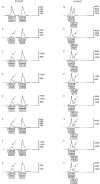Familial cutaneous leiomyomatosis is a two-hit condition associated with renal cell cancer of characteristic histopathology
- PMID: 11549574
- PMCID: PMC1850481
- DOI: 10.1016/S0002-9440(10)61757-9
Familial cutaneous leiomyomatosis is a two-hit condition associated with renal cell cancer of characteristic histopathology
Abstract
Little has been known about the molecular background of familial multiple cutaneous leiomyomatosis (MCL). We report here a clinical, histopathological, and molecular study of a multiple cutaneous leiomyomatosis kindred with seven affected members. This detailed study revealed strong features of a recently described cancer predisposition syndrome, hereditary leiomyomatosis and renal cell cancer (HLRCC). The family was compatible with linkage to the HLRCC locus in 1q. Also, all seven cutaneous leiomyomas derived from the proband and analyzed for loss of heterozygosity displayed loss of the wild-type allele, confirming the association with a susceptibility gene in chromosome 1q. One individual had had renal cell cancer at the age of 35 years. This tumor displayed a rare papillary histopathology, which appears to be characteristic for HLRCC. The derived linkage, loss of heterozygosity, and clinical data suggest that MCL and HLRCC are a single disease with a variable phenotype. The possibility that members of leiomyomatosis families are predisposed to renal cell cancer should be taken into account.
Figures



References
-
- Virchow R: Uber Makroglossie und pathologische Neubildung quergestreifter Muskelfasern. Virchows Arch Pathol Anat 1854, 7:126-138
-
- Sonck CE: Myomatosis cutis miliaris: report of a case. Acta Dermatol Venereol 1951, 31:297-303 - PubMed
-
- Mezzadra G: Leiomioma cutaneo multiplo ereditario. Studio di un caso sistematizzato in soggetto maschile appartenente a famiglia portatrice di leiomiomatosi cutanea e fibromiomatosi uterina. Minerva Derm 1965, 40:388-393 - PubMed
-
- Reed WB, Walker R, Horowitz R: Cutaneous leiomyomata with uterine leiomyomata. Acta Derm Venerol 1973, 53:409-416 - PubMed
Publication types
MeSH terms
LinkOut - more resources
Full Text Sources
Medical

